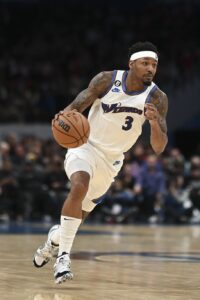Nearly a full month into free agency, the number of impact free agents is dwindling by the day. Veterans like P.J. Washington, Christian Wood and Kelly Oubre are among the most notable players still on the market — they would be fits for most contenders and have each been linked to numerous teams. However, beyond the big names, there are several free agents who made positive impacts on their respective clubs and likely wouldn’t cost much.
Some available free agents include players who began the offseason on teams but were cut, either for financial or fit reasons, including Edmond Sumner, Trendon Watford and Lamar Stevens. Sumner and Stevens are the players with the most NBA experience out of this group, holding 161 and 165 games of experience respectively. Sumner averaged 7.1 points for the Nets last year after missing the 2021/22 season with an Achilles injury while Stevens went undrafted in 2020 but evolved into a key rotation player for the Cavaliers, averaging 5.3 points in three seasons there and making 38 starts.
Watford, on the other hand, has appeared in 110 NBA games after going undrafted in 2021. While he flew under the radar as a member of retooling Trail Blazers squads, he showed quite a bit of promise in two seasons in Portland, so it was somewhat surprising to see him go. Watford averaged 7.5 points and 4.0 rebounds in two seasons in Portland.
Then there are other free agents who have outright gone unsigned to this point. As we wrote yesterday, Derrick Jones Jr. is the only player who is still available after turning down an option for 2023/24. Jones is a high-flying forward who is still just 26 years old despite holding seven years of NBA experience.
Javonte Green is another Bulls free agent who could appeal to teams. Green has 186 games of NBA experience and started in 45 of his 65 appearances in ’21/22 for the Bulls. Meanwhile, Hamidou Diallo is another high-flying athlete who remains available after averaging 8.6 points across 263 career appearances in Oklahoma City and Detroit. He will be just 25 when the season begins.
Other available relatively young players who have proven themselves in past NBA seasons include Kendrick Nunn, who averaged 15.0 points in two seasons with Miami, Jaylen Nowell, who has reportedly drawn interest from the Mavericks, and Terence Davis, who averaged 10.4 points for Sacramento in ’21/22.
Regardless of what teams are looking for, there remain a plethora of options. If clubs are looking to fill out their rosters with veterans, players like George Hill, Will Barton, Danny Green, Ish Smith, JaMychal Green, Terrence Ross and T.J. Warren are available. If teams are looking for high-upside options, guys like Frank Ntilikina, Kevin Knox, Justise Winslow and Romeo Langford are available as former lottery picks who are all 27 or younger. Other guys who flew under the radar last season but impressed in brief stints include Lindy Waters, Jeenathan Williams and Skylar Mays.
Lastly, teams aren’t limited to guys who finished last season on NBA teams. Players like Lance Stephenson and Glenn Robinson III are reportedly seeking NBA comebacks. Ben McLemore, Dion Waiters and Stanley Johnson are some of the other players who fit this bill as guys who either worked out for teams or could hold some appeal as options to fill the bench.
That brings us to our Community Shootaround question(s) of the day: Who do you think is the most overlooked player who is still available in free agency? What teams do you think should sign these players? Is there anyone we missed?
Let us know what you think by sharing your thoughts in the comments section. We look forward to hearing what you think.
 When the Wizards signed
When the Wizards signed